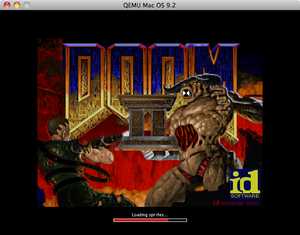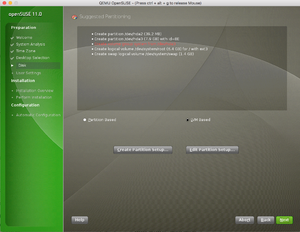Set up this QEMU distribution in OSX 10.10.5 for installing Mac OS X 10.3. I used Disk Utility in OSX to create disk images from the three Mac OS X 10.3 install disks in DVD/CD Master (.cdr) format. I used qemu-img to create a 6G raw disk image for the installation target volume. First installer image is named '10.3InstallDisc1.cdr'. Mac OS X 10.3: It can be installed and used. Mac OS X 10.4: It can be installed and used. Mac OS X 10.5: It can be installed and used (Use the mac99P Model). NOTE Rhapsody!:Mac OS have Rhapsody for x86. Every x86 Rhapsody versions can be run in VMWare and Virtualbox. Aug 12, 2020 chmod +x qemu.command. Short explanation of the content of the file: #!/bin/bash tells OSX this is a bash script cd “$(dirname “$0”)” set the path for the executable to current folder./qemu-system-ppc starts qemu with all the following as parameters:-L pc-bios points qemu to some required files, including openbios-ppc and the vga driver qemuvga.ndrv.boot d defines to boot from a. It worked like a charm. I carried my QEMU folder on my keychain USB drive and popped it into my Mac and copied over the folder, installed some software, created a new configuration, and fired up the VM. This post will cover that process, and how to hack a Mac OS X bundle or package to execute the precise QEMU command that we need.

Mac OS 10.4 (PowerPC) in QEMU
Now that Apple has ended supporting PowerPC applications having Mac OS 10.4 around can be a life saver. With it you can continue to use your favorite PowerPC applications.
Suggested command-line:
To boot in verbose mode add this:
This makes sound work, but it doesn't work on Mac OS 10.4.11. It does work with Mac OS 10.4.3:
Software:
Notes:
To prevent the guest from freezing turn off all setting in the Energy Saver pane in System Preferences. Set the sleep and display sliders to Never. Uncheck the 'Put the hard disk(s) to sleep when possible' checkbox.
It is also suggested to turn off the screen saver. Open the the 'Desktop & Screen Saver' pane in System Preferences and slide the 'Start screen saver:' slider to Never.
Issues:
Sound currently doesn't work very well. It might have static to it like playing a vinyl record.
Pictures:
Links:

PowerPC software archive
Low End Mac article on Mac OS 10.4
Contact:
This page documents how to create a hard disk image in QEMU.
The command[edit]
The standard command for creating a basic hard disk image is this.
It will create an output similar to this:
The command is broken down like this:
- qemu-img - This is the name of the program. It is necessary for using the following command.
- create - This tells qemu-img that we are creating a disk image. Other arguments include 'dd', 'info', 'map', 'measure', 'snapshot', 'rebase', and 'resize'. This will be described in more detail later on.
- -f - An argument that specifies which file format we are going to be using.
- qcow2 - The file format we are using, in this case qcow2. qcow2 is the recommended since it is dynamically allocated - e.g. it only allocates space when needed, but at a (pretty much) unnoticeable speed loss. There are many other file formats, which will be listed below.
- example.img - This specifies the name of the image we are going to be using. It can be whatever, and have whatever extension (or none at all), it doesn't matter.
- 100M - This specifies the size of the virtual disk. 100M stands for 100 megabytes. Of course modern operating systems take up much more than that, so it's recommended to make it at least 30 gigabytes or more, which can be done by replacing 100M with 30G. The following letters are excepted:
- K - K stands for Kilobytes. For instance, 100K would be 100 kilobytes. Unrecommended. You can create hard disk images in pure kilobytes if you wanted, e.g. 30000000k for 30 gigabytes.
- M - M stands for Megabytes. For instance, 100M would be 100 megabytes. You can also create hard disk images in pure megabytes if you want, e.g. 30000M for 30 gigabytes.
- G - G stands for Gigabytes. For instance, 100G would be 100 gigabytes.
- T - T stands for Terabytes. For instance, 1T would be 1 terabyte.
- P - P stands for Petabytes. For instance, 1P would be 1 petabyte. Unrecommended unless you happen to have a supercomputer handy.
- E - E stands for Exabytes. For instance, 1E would be 1 exabytes. Unrecommended unless you happen to have a supercomputer handy. Fun fact: The ext4 file system is capable of a maximum of 1.1529215 exabytes.
File formats[edit]

QEMU can recognize and read several different file formats, but this section will list the ones you can create with qemu-img.
Install Mac Os On Qemu
qcow2[edit]
The recommended file format. It is fast, dynamically allocated, and has decent support in QEMU. However it does have a minor speed loss compared to raw, but this is unnoticeable in normal use.
qcow[edit]
This is an older version of the qcow2 file format. The main difference between the qcow2 and qcow file formats is that qcow2 supports multiple snapshots through a newer, flexible model for storing snapshots. It is recommended to use qcow2 instead.
raw[edit]
As the name suggests - it is a 'raw' file format, which means it will allocate all the space to the disk immediately, e.g. if you formatted a file named raw with 2G as the size, it would take up 2 gigabytes of space on the disk. This is the fastest option, and is recommended if you have a lot of disk space to spare.

vdi[edit]
A file format which is also compatible with VirtualBox 1.1. Recommended only if you are going to be switching through VirtualBox and QEMU frequently.
- static - If set, the image will be created with metadata preallocation.
vmdk[edit]
A file format which is compatible with VMWare 3 and 4. Recommended only if you are going to be switching through VMWare and QEMU frequently. It supports the following arguments:
- compat6 - Create a VMDK 6 image, instead of the default VMDK 4.
- hwversion - Specify the vmdk virtual hardware version. If set, the Compat6 flag cannot be enabled.

vpc[edit]
A file format which is compatible with Windows Virtual PC. Recommended only if you are going to be switching through Windows Virtual PC and QEMU frequently.
vhdx[edit]
A Hyper-V compatible image format. Not recommended unless you're going to switch between Hyper-V and QEMU frequently.
Teach, Learn, And Make With Raspberry Pi – Raspberry Pi
parallels[edit]
A Parallels compatible image format. Not recommended unless you're going to switch between Parallels and QEMU frequently.
file[edit]
Not a file with any format - just a plain raw file.
cow[edit]
Cached
Pandem kollu 2. Ancient, depreciated QEMU file format that is not present in newer versions. Like qcow2 and qcow, it is a dynamically allocated file format. This cannot be used in Win32. Not recommended.
Read only file formats[edit]
- bochs - Bochs image file
- cloop - Linux Compressed Loop image, useful only to reuse directly compressed CD-ROM images present for example in the Knoppix CD-ROMs.
- dmg - Apple disk image
